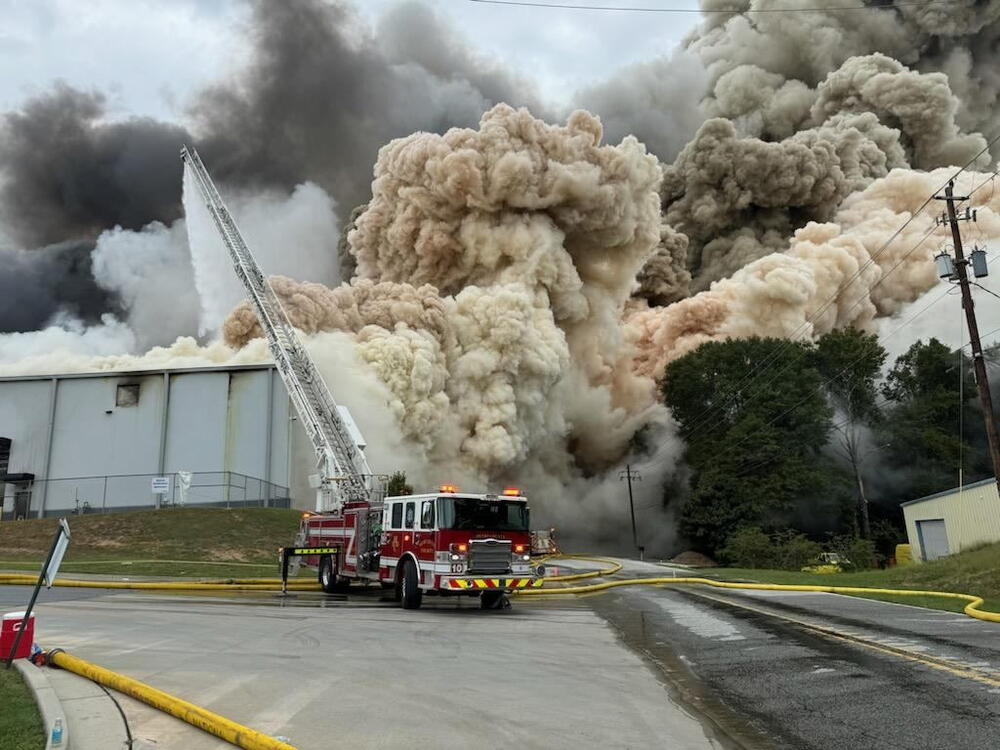
Caption
A chemical plume and heavy smoke rise from the BioLab facility in Conyers, Ga., as firefighters respond to a chemical fire on Sept. 29, 2024.
Credit: Stephanie Donnelly
|Updated: May 28, 2025 10:09 AM
LISTEN: A new federal update reveals BioLab stored twice the intended amount of reactive chemicals before a fire at its Conyers, Ga., facility. GPB's Pamela Kirkland reports.

A chemical plume and heavy smoke rise from the BioLab facility in Conyers, Ga., as firefighters respond to a chemical fire on Sept. 29, 2024.
Updated 5/28/25 with BioLab's comment.
Federal investigators say BioLab was storing nearly 14 million pounds of water reactive chemicals when the storage warehouse in Conyers, Ga., caught fire Sept. 29, more than twice the amount the company initially intended to store.
The U.S. Chemical Safety Board (CSB) released its second investigation update Friday, revealing that water reactive chemicals were stored in large bulk bags, known as "super sacks," each holding about 2,750 pounds of material. The super sacks were stacked high, and in some cases stored outside designated racks.
Plant 12, where the fire occurred, had two sections separated by a firewall designed to help contain or slow the spread of fire between areas of the warehouse. Investigators said nearly 3 million pounds of chemicals were stored outside the firewall. The CSB also reported the bulk chemical bags were not separated from other materials and were often stacked together in racking systems alongside other dry chemicals.
The report also notes that a firewall meant to contain the flames failed, allowing the fire to spread further through the warehouse.
In a separate report released in April, the U.S. Department of Labor’s Occupational Safety and Health Administration (OSHA) said that improperly stored chemicals led to the fire that broke out at BioLab’s Conyers warehouse and proposed a $61,473 fine. OSHA cited multiple serious violations related to chemical storage, emergency response and worker protection.
The CSB investigation also found corrosion on a sprinkler pipe near where the fire is believed to have started. Investigators said that’s not surprising, given the corrosive nature of the chemicals being stored.
“The impacts from storing corrosive material at the storage warehouse became visible shortly after BioLab started using the new building,” the CSB report states. "[Trichloroisocyanuric acid] storage began in the storage warehouse bunker on November 5, 2019, and photographs indicated that there was corrosion on metal structure components and sprinkler heads as soon as December 30, 2019."
In the initial 911 call placed the morning of the fire, a BioLab employee reported that a sprinkler head had burst inside the facility. CSB investigators found corrosion on a sprinkler pipe near the area where the fire is believed to have started. Whether that corrosion contributed to the fire or compromised the facility’s fire suppression system remains under investigation.
That finding echoes concerns raised by Randy Garcia, a former engineer who worked at BioLab from August 2022 to April 2024. Speaking to GPB prior to the CSB’s latest update, Garcia said that he was the only engineer on site and had questioned the use of a water-based fire suppression system in a facility storing chemicals known to react with water.
“I brought up questions about 'Why do we have a water-based fire system over water-reactive chemicals?'” Garcia told GPB. “I brought the risks that could come about, but we got approvals on everything. Management was like, 'No one is forcing us to change it.' [Rockdale] County's OK with it, they say OSHA gave the OK, nobody really raised any red flags, so nothing was really done about it.”
Garcia said he replaced about 40 sprinkler heads during his time at the plant.
“A lot of the sprinkler heads were just faulty," he said. "So, I spent a good amount of money replacing them.”
The CSB also noted that a large amount of water was already flowing out of the building before firefighters arrived, suggesting the fire suppression system may have activated.
Additionally, investigators reported that the facility’s roof was leaking, raising the possibility that stormwater entered the building and contributed to the reaction.
“The more we learn about this unacceptable incident, the more disturbing it is,” CSB chairperson Steve Owens said in a press release. “This is a stark reminder of the very serious dangers that can occur when enormous amounts of reactive and corrosive chemicals are stored without proper safeguards in place.”
Earlier this month, BioLab announced the Conyers plant would not resume manufacturing but would continue to operate as a distribution facility. The company also said it had completed remediation work following the September fire. The response to the announcement from residents was mixed.
The CSB investigation is ongoing. A final report with formal safety recommendations is expected later this year.
BioLab did not immediately respond to a request for comment on the latest CSB report. On May 27, a BioLab spokesperson said in a statement that the company “will continue to cooperate with the CSB’s ongoing investigation, although we disagree with many of CSB’s statements.”
For more on the 2024 fire and GPB’s investigation, listen to “Manufacturing Danger: The BioLab Story” wherever you get your podcasts.